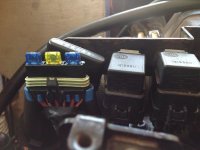[FONT=Lucida Grande, Trebuchet MS, Verdana, Helvetica, Arial, sans-serif]Spent the last couple of months rebuilding a 5.0 merc in a regal 2100[/FONT]
Unfortunately went for start today and no noise.
It does motor over
But
1. No noise from fuel pump so guess it's not working
2. No spark fro plug and no power to coil positive
I guessing l have a power supply issue, l get power to the engine plug, power to the fuse panel.
Where should l go to next ?
Unfortunately went for start today and no noise.
It does motor over
But
1. No noise from fuel pump so guess it's not working
2. No spark fro plug and no power to coil positive
I guessing l have a power supply issue, l get power to the engine plug, power to the fuse panel.
Where should l go to next ?



